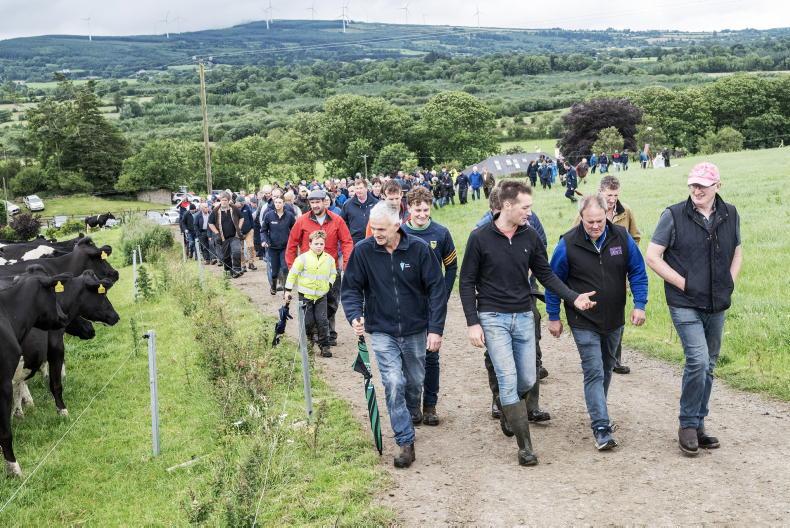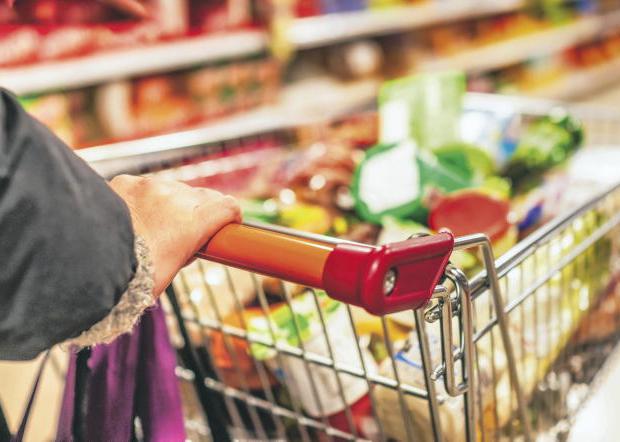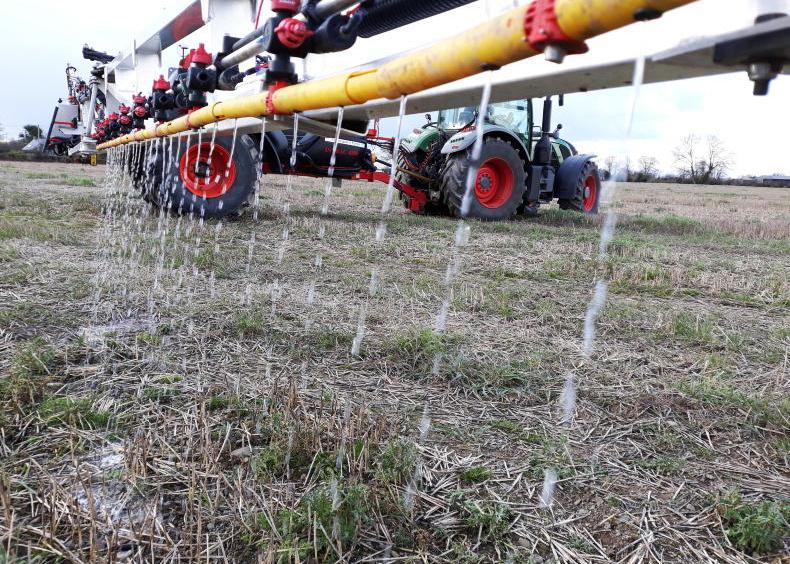The third version of the Teagasc Marginal Abatement Cost Curve (MACC) 2023 identifies the range of climate mitigation actions available to Irish farmers.
It helps farmers, and other industry stakeholders, to identify the most impactful measures, while also providing insights into the least costly actions to reduce greenhouse gas (GHG) emissions.
The Teagasc Signpost Programme team has translated the MACC measures into a series of “12 steps” for the various farm enterprises, including dairy, suckler beef, dairy calf to beef, sheep and tillage.
Some of the measures are common to all enterprises, for example reduced nitrogen (N) fertiliser use, while others are relevant for just one enterprise, for example straw incorporation for tillage, or finishing age for beef farmers.
The “12 steps” include MACC technologies that are currently available for use by farmers.
There is an urgency to get these technologies adopted at farm level in order for agriculture to reduce its GHG emissions by 25% by 2030.
Additionally, many of these MACC technologies are cost-saving or cost-neutral at farm level.
Future technologies, eg methane-reducing feed or slurry additives, while included in MACC, are not currently included in the “12 steps”. Once such technologies are available, the “12 steps” will be adjusted.
This article reviews the progress made by farmers in adopting the MACC measures.
Use protected urea
Fertiliser sales data indicates an upward trend in the sales volume and percentage of total chemical N sold in protected urea form. The usage of protected urea has increased on all farm systems, with the most noticeable increase occurring on dairy farms, where 15% of fertiliser N was applied as protected urea in 2022. There is an urgent requirement to increase this use significantly.
Apply lime
Annual lime usage has increased from, on average, 700,000t per year in the 2000 to 2012 period to 1,000,000t in the 2013 to 2022 period, according to Central Statistics Office (CSO) data, with almost 1,400,000t applied in 2022 alone.

Lime use has been increasing.
Earlier this year, the National Liming Programme was massively oversubscribed, with 41,000 farmers applying for the €16/t grant to apply up to 4,500,000t of lime.
According to provisional Teagasc National Farm Survey (NFS) data, 53% and 27% of dairy and drystock farmers, respectively, applied lime in 2022.
Build or maintain
soil fertility
Usage of both chemical phosphorous (P) and potassium (K) increased up to 2021 on Irish farms, but there was a sharp drop-off in the usage of both elements in 2022.
P usage reduced by 11,828t (26%) in 2022, while K usage reduced by 29,308t (24%) in the same year. This is a concerning development, especially given the inclusion in MACC of a measure to improve overall soil fertility.
Teagasc data indicates that overall soil fertility status has improved on Irish farms, as measured by soil samples analysed over the past decade.
Currently, approximately 20% of soil samples are classed as having optimum status (soil pH > 6.2, P index = 3 or 4, K index = 3 or 4), whereas this figure was 10 – 12% in the 2010 to 2016 period.
Use 100% LESS
Both dairy and cattle farmers have adopted low-emission slurry spreading (LESS) technology, due to advice from Teagasc, capital incentives through TAMS and new regulations requiring its use on highly stocked farms.

Low emissions slurry spreading. \ Donal O'Leary
Provisional results from the Teagasc NFS for 2022 show that 75% and 33% of slurry on the average dairy and cattle farm, respectively, was applied via LESS.
Incorporate clover into grass swards
The sales of both white and red clover seeds have increased significantly in the last decade, with a 61% increase in sales of white clover seed.

Incorporating clover into swards is a key action in the new MACC. \ Donal O'Leary
Reduce fertiliser N use
There was a big decline in N fertiliser use in 2022 to 343,000t – a decline of 16% compared to the 2018 usage.
While the high cost of fertiliser in 2022 and issues around availability impacted on fertiliser usage in 2022, the increased use of clover, liming, improved soil fertility and better use of animal manures (eg using LESS) have all facilitated this reduction.
The data for 2023, once available, will highlight whether decisions made by farmers in relation to N fertiliser usage in 2022 are now embedded.
Provisional Teagasc NFS data indicates declines in chemical N usage across all farm systems in 2022.
Reduce age at slaughter
The beef farming sector has made good progress in increasing liveweight performance in recent years, with related reductions in slaughter age evident for most categories of cattle.

Spring-born Friesian steers were slaughtered 60 days earlier in 2020 than in 2011.
ICBF data indicates that spring-born Friesian steers were slaughtered 60 days earlier in 2020, compared to similar animals slaughtered in 2011. Spring-born suckler steers were slaughtered 45 days earlier than similar animals slaughtered in 2011.
Increase EBI
Recent research has shown that methane emissions from higher-EBI cows were similar to lower-EBI cows, even though the higher-EBI cows produced more milk.

Higher EBI cows produce more milk but without a corresponding increase in methane emissions.
Currently, the EBI of the national herd is increasing by approximately €10/year; this equates to a 0.32% decrease in methane emissions.
Incorporate straw
Increasing numbers of farmers have participated in the Straw Incorporation Measure scheme since it was launched in 2021. Some 3,500 tillage farmers have applied to chop over 70,000ha of straw in this year’s harvest. Some 1,700 farmers availed of the scheme in 2021, while 2,500 farmers did so in 2022.
In summary, farmers are already adopting a range of MACC measures. The measures described also highlight the role that research, advisory services, legislation and incentives play in increasing the uptake of mitigation technologies; all four elements have a role to play in accelerating the adoption of the MACC measures.
Teagasc, through its Signpost Advisory Programme, is here to help all farmers on their journey to reducing GHG emissions from farming.
The third version of the Teagasc Marginal Abatement Cost Curve (MACC) 2023 identifies the range of climate mitigation actions available to Irish farmers.
It helps farmers, and other industry stakeholders, to identify the most impactful measures, while also providing insights into the least costly actions to reduce greenhouse gas (GHG) emissions.
The Teagasc Signpost Programme team has translated the MACC measures into a series of “12 steps” for the various farm enterprises, including dairy, suckler beef, dairy calf to beef, sheep and tillage.
Some of the measures are common to all enterprises, for example reduced nitrogen (N) fertiliser use, while others are relevant for just one enterprise, for example straw incorporation for tillage, or finishing age for beef farmers.
The “12 steps” include MACC technologies that are currently available for use by farmers.
There is an urgency to get these technologies adopted at farm level in order for agriculture to reduce its GHG emissions by 25% by 2030.
Additionally, many of these MACC technologies are cost-saving or cost-neutral at farm level.
Future technologies, eg methane-reducing feed or slurry additives, while included in MACC, are not currently included in the “12 steps”. Once such technologies are available, the “12 steps” will be adjusted.
This article reviews the progress made by farmers in adopting the MACC measures.
Use protected urea
Fertiliser sales data indicates an upward trend in the sales volume and percentage of total chemical N sold in protected urea form. The usage of protected urea has increased on all farm systems, with the most noticeable increase occurring on dairy farms, where 15% of fertiliser N was applied as protected urea in 2022. There is an urgent requirement to increase this use significantly.
Apply lime
Annual lime usage has increased from, on average, 700,000t per year in the 2000 to 2012 period to 1,000,000t in the 2013 to 2022 period, according to Central Statistics Office (CSO) data, with almost 1,400,000t applied in 2022 alone.

Lime use has been increasing.
Earlier this year, the National Liming Programme was massively oversubscribed, with 41,000 farmers applying for the €16/t grant to apply up to 4,500,000t of lime.
According to provisional Teagasc National Farm Survey (NFS) data, 53% and 27% of dairy and drystock farmers, respectively, applied lime in 2022.
Build or maintain
soil fertility
Usage of both chemical phosphorous (P) and potassium (K) increased up to 2021 on Irish farms, but there was a sharp drop-off in the usage of both elements in 2022.
P usage reduced by 11,828t (26%) in 2022, while K usage reduced by 29,308t (24%) in the same year. This is a concerning development, especially given the inclusion in MACC of a measure to improve overall soil fertility.
Teagasc data indicates that overall soil fertility status has improved on Irish farms, as measured by soil samples analysed over the past decade.
Currently, approximately 20% of soil samples are classed as having optimum status (soil pH > 6.2, P index = 3 or 4, K index = 3 or 4), whereas this figure was 10 – 12% in the 2010 to 2016 period.
Use 100% LESS
Both dairy and cattle farmers have adopted low-emission slurry spreading (LESS) technology, due to advice from Teagasc, capital incentives through TAMS and new regulations requiring its use on highly stocked farms.

Low emissions slurry spreading. \ Donal O'Leary
Provisional results from the Teagasc NFS for 2022 show that 75% and 33% of slurry on the average dairy and cattle farm, respectively, was applied via LESS.
Incorporate clover into grass swards
The sales of both white and red clover seeds have increased significantly in the last decade, with a 61% increase in sales of white clover seed.

Incorporating clover into swards is a key action in the new MACC. \ Donal O'Leary
Reduce fertiliser N use
There was a big decline in N fertiliser use in 2022 to 343,000t – a decline of 16% compared to the 2018 usage.
While the high cost of fertiliser in 2022 and issues around availability impacted on fertiliser usage in 2022, the increased use of clover, liming, improved soil fertility and better use of animal manures (eg using LESS) have all facilitated this reduction.
The data for 2023, once available, will highlight whether decisions made by farmers in relation to N fertiliser usage in 2022 are now embedded.
Provisional Teagasc NFS data indicates declines in chemical N usage across all farm systems in 2022.
Reduce age at slaughter
The beef farming sector has made good progress in increasing liveweight performance in recent years, with related reductions in slaughter age evident for most categories of cattle.

Spring-born Friesian steers were slaughtered 60 days earlier in 2020 than in 2011.
ICBF data indicates that spring-born Friesian steers were slaughtered 60 days earlier in 2020, compared to similar animals slaughtered in 2011. Spring-born suckler steers were slaughtered 45 days earlier than similar animals slaughtered in 2011.
Increase EBI
Recent research has shown that methane emissions from higher-EBI cows were similar to lower-EBI cows, even though the higher-EBI cows produced more milk.

Higher EBI cows produce more milk but without a corresponding increase in methane emissions.
Currently, the EBI of the national herd is increasing by approximately €10/year; this equates to a 0.32% decrease in methane emissions.
Incorporate straw
Increasing numbers of farmers have participated in the Straw Incorporation Measure scheme since it was launched in 2021. Some 3,500 tillage farmers have applied to chop over 70,000ha of straw in this year’s harvest. Some 1,700 farmers availed of the scheme in 2021, while 2,500 farmers did so in 2022.
In summary, farmers are already adopting a range of MACC measures. The measures described also highlight the role that research, advisory services, legislation and incentives play in increasing the uptake of mitigation technologies; all four elements have a role to play in accelerating the adoption of the MACC measures.
Teagasc, through its Signpost Advisory Programme, is here to help all farmers on their journey to reducing GHG emissions from farming.














SHARING OPTIONS